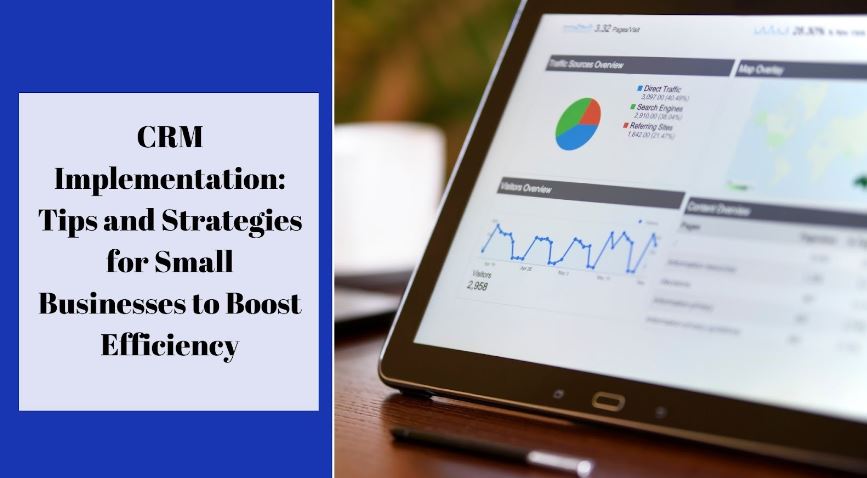Customer relationship management software is a vital tool for all types of businesses. CRM helps them manage relationships with customers and possible new customers. Setting up CRM can boost sales and improve customer satisfaction for small companies. It also streamlines business operations, making everything run more smoothly.
But small businesses can also have a tough time getting CRM up and running. They don’t always have big budgets or a ton of people to help. So small businesses need to be careful and smart about how they add CRM. The key is making every dollar spent on CRM count.
This article gives tips for small businesses. The tips will help small businesses put CRM to work in their business in a smooth way. CRM can help small businesses be more productive and successful when it’s done right.
Why CRM Matters for Small Businesses
Adopting customer relationship management software might seem like an unnecessary hassle. Or it might seem like an unnecessary expense for some small businesses. But there are compelling reasons why CRM should be a priority:
Improve Customer Retention and Loyalty:
Tracking interactions and data in one place helps businesses understand customer needs. They can also nurture relationships more effectively. This leads to improved customer retention and loyalty.
Enhance Sales Processes:
CRM provides insights into sales opportunities and pipelines. This helps companies close more deals faster. Sales features like lead scoring also assist with qualifying and converting leads.
Gain Business Insights:
With all customer data in one place, small businesses can identify upsell opportunities. They can also understand sales cycles better and make smarter business decisions.
Increase Productivity:
CRM automates many tasks like data entry, to save time and money. Employees can also access the information they need faster.
Improve Customer Service:
Having a complete customer view allows small businesses to provide personalized service. This knowledgeable service delights customers.
The main thing is CRM lets small businesses be more powerful. It uses technology to improve every interaction with customers. When small businesses put real thought into setting up simple CRM software, it gives an affordable way to sell more, get more done, and run smoother. CRM helps small businesses achieve big results.
Data Source: superoffice.com
Essential Pre-Implementation Groundwork
The most critical work for CRM success in small businesses occurs before setup. Taking time early to make plans and build groundwork is key. It will help get CRM running smoothly and working right away. Doing the preparation steps ahead of time sets up small businesses for CRM success down the road.
Define Your CRM Needs and Goals
Before evaluating specific CRM solutions, small businesses should identify their priorities. They should also identify objectives for implementing a CRM system. Some examples of goals could include:
-
Improve lead conversion rates by 25%.
-
Cut time spent on manual data entry by 50%.
-
Increase customer loyalty engagement scores by 30%.
Clear metric-driven goals simplify CRM selection for the needed functionality. Always focus on the business challenges to solve rather than features.
Review Your Sales Process and Workflows
Assess how sales, marketing, and customer service currently operate in your small business. Look for any areas that are inefficient, missing steps, or causing problems in how work is done now.
CRM may be able to improve these workflow issues. Understand the biggest workflow problems that need fixing before picking a CRM tool. Choose a CRM that can fix those specific process issues.
Audit Your Existing Data and Systems
Gather scattered customer information from emails, spreadsheets, and people’s heads. Clean up and consolidate this data because it will need to migrate to the new CRM platform.
Also, document any other business systems and software currently in use. Determine CRM integration with other tools, including the existing email platform.
Define CRM User Roles and Permissions
Determine who will use the CRM system and what they will use it for. Define roles, access levels, and permissions based on their responsibilities.
Proper user setup is essential for driving adoption. It applies across sales, marketing, customer service, and support teams.
Calculate Your Budget
Research pricing models like monthly subscriptions for Software-as-a-Service or SaaS CRM platforms, which may facilitate small business budgets rather than large upfront license fees.
Allocate the budget for any customized integrations, training, and change management activities while also exploring the possibility of securing small business loans to support your CRM implementation.
Involve the Right Team Members
Secure user buy-in by involving department leads at the start. These leaders come from sales, marketing, IT, and customer service. Involve them in the needs assessment and planning process. Identify CRM champions who will be trainers and evangelists for adoption.
Choosing the Right CRM Software
Once the groundwork is complete, small businesses can start evaluating CRM software. They can also start identifying the best software for their needs and budget. Keep the following criteria in mind during selection:
Simplicity and Ease of Use
Complex systems with a steep learning curve lead to low user adoption. Make the CRM interface intuitive and easy to use. This allows employees to easily get the CRM information they need fast.
Salesforce Automation Features
The right sales CRM tools can significantly boost productivity for sales teams. Out-of-the-box features like opportunity scoring, and managing pipelines are crucial. Handling contact/account, and reporting sales is also vital. They are essential for sales teams.
Customer Support Capabilities
Evaluate capabilities like ticketing, knowledge base, and self-service options. These enable small business customer service teams to deliver top-notch support.
Mobility and Access
Ensure the CRM platform offers mobile functionality and offline access. This allows employees to work productively anytime, anywhere—at the office, at home, or on the go.
Scalability and Flexibility
As small businesses grow and evolve, the CRM should scale with changing needs. Look for customizable features that adapt as processes mature.
Integration and Compatibility
The CRM should integrate seamlessly with other systems. These systems include email, calendar, and accounting software. This creates an ecosystem that supports workflows.
Budget Fit
Carefully consider the pricing model and weigh costs against the value delivered. A CRM that boosts efficiency, insights, and revenues justifies the long-term investment.
By using these criteria, small businesses can choose an ideal CRM for their needs. This ensures the software fits both their requirements and budget.
Rolling Out Your CRM System
With the software chosen, it’s time to plan and execute the CRM implementation. Follow these best practices for rolling out CRM smoothly:
Phase the Rollout
Avoid trying to switch CRM systems overnight. Gradually phase capabilities, starting with non-sales teams first. This allows for learning before bringing sales on board. Manage any legacy CRM transition carefully.
Clean and Deduplicate Data
Remember that data audit during planning? Use the initial rollout phase to clean up and migrate the vetted customer data into the new CRM. Take time to remove duplicate records.
Personalize Configurations
Customize fields, layouts, workflows, and settings to fit business processes and user preferences. While personalized, maintain a level of consistency across teams for maximum adoption.
Train Staff on the New CRM
Proper training and change management is imperative for user adoption. Run required onboarding sessions with role-based guidance for sales, service, and support teams. Guide them on how to use the CRM in their day-to-day work.
Define and Monitor Key Metrics
Leverage CRM reporting to define metrics aligned with the original implementation goals. Also, use it to track those objectives. Monitor progress frequently and continue optimizing.
Iterate Based on Feedback
Ask users for feedback during and after the rollout. This helps spot fixes and extra ways to customize CRM to make it easier to use. Make changes based on what users say to get everyone on board.
Incremental CRM improvements tailored to user needs ease employee adoption. This user-centric approach aids in effective initial months of CRM usage. When users see CRM improve for them, they will want to use it more.
Driving Long-Term Adoption and Success
The work doesn’t stop once CRM is rolled out. Consistent reinforcement and optimization are required to achieve the full value.
Continue Training and Education
Training is not one-and-done. Provide updates to employees on CRM changes through refreshers and lunch-and-learns.
Define CRM Success Metrics
Track CRM performance through KPIs. This includes resolved support cases, converted leads, customer satisfaction, and user adoption. Recognize and reward success.
Communicate CRM Benefits
Share success stories, customer testimonials, and quick wins resulting from CRM usage. This showcases the value delivered to both customers and employees.
Refine Business Processes Around CRM
Regularly update any workflows or processes that involve the CRM. Do this to take advantage of the latest features and maximize efficiency gains.
Integrate with other tools
When new tools are introduced, make sure they integrate seamlessly with CRM. Use APIs and embedded links to maintain data accuracy as a single source of truth.
Make CRM Part of the Company’s Culture
When CRM is ingrained into everyday tasks and habits, adoption sticks. Cultivate this through training, goal-setting, and leadership communication.
To succeed, organizations must focus on continuous user adoption in technology implementations. They must also commit to driving engagement long after the initial rollout. The same holds true for small business CRM success.
Conclusion
Setting up CRM the right way is smart for small businesses. It can make processes better. And make sales, marketing, and customer service teams more productive.
Following the step-by-step approach here helps avoid problems putting CRM in place. It gets businesses ready to use CRM fully, right away, and long term.
Once CRM is working well, use its data to make smart choices. CRM reports and analysis lead to better decisions. Those that help grow more and make customers happier.
The data from CRM is powerful. Use it to understand customers. To sell more. Improve marketing. And give great service. CRM data can take a small business to the next level.
Setting up CRM takes effort up front. But it pays off over time in growth. The key is using CRM data to make strategic business choices. Choosing the right CRM platform is an investment in success.
FAQs
1. How long does CRM implementation take?
For small businesses, plan for an end-to-end implementation process spanning around 2-3 months. The timeline depends on the implemented capabilities and integration complexity.
2. What are typical CRM costs for small businesses?
Small companies often set aside $200-$500 per user annually for hosted SaaS CRM solutions. Upfront licensing for on-premise CRM is more costly.
3. Should we use an out-of-the-box CRM or customize it?
The best approach is “configure don’t customize”. Leverage out-of-the-box capabilities as much as possible. Only customize when essential to support specific processes. Resist over-customization.



